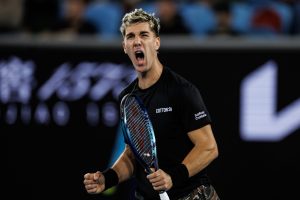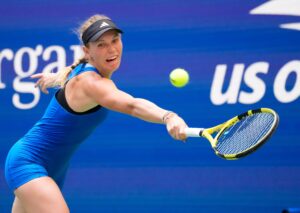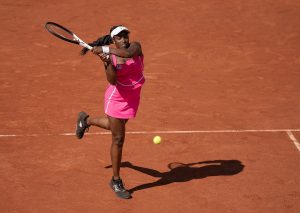Having looked back at the highlights and lowlights of 2018, our resident tennis historian, Martin Keady, looks ahead to 2019.
2018 was a genuinely historic year for tennis, as it marked the 50th anniversary of the start of the Open era, when the sport finally went fully professional after years, if not decades, of “shamateurism”. In 2019, tennis will start its second half-century as a truly open and inclusive sport, and here are 10 things to look forward to in the year ahead.
- ANDY MURRAY’S COMEBACK
Having missed almost all of 2018 while recovering from the hip operation that he underwent nearly a year ago, Andy Murray will be desperate to make up for lost time – lots of lost time. All the recent reports about his rehabilitation have been encouraging, not least the clips he has posted of some of the bizarre exercises that he has had to do to rebuild his strength and conditioning, including hand-stands and paddling in an imaginary canoe.
Having seen “The Big Three” of Federer, Nadal and Djokovic enjoy their own remarkable comebacks in the last two seasons (between them, they have won every Major since Melbourne in 2017), Britain’s tennis knight will hope that he, too, can prove that he is far from being past his best. In an absolutely ideal world, he will return to the incredible form that he has shown for almost all of his career prior to 2018 and bring down the curtain on that career by claiming a unique “double hat-trick”: a third Wimbledon Men’s Singles title; and a third Olympic Men’s Singles Gold at Tokyo in 2020.
- CAROLINE WOZNIACKI PLAYING THROUGH THE PAIN OF ARTHRITIS
Caroline Wozniacki must be a little unsure how to look back on 2018. It began with her finally winning the Major that her major talent has always merited, as she defeated Simona Halep in an epic Australian Open Women’s Final that left Halep temporarily hospitalised with dehydration. However, the year ended with her announcement that she has been diagnosed with rheumatoid arthritis.
Wozniacki has already said that she wants to be a role model to the estimated 350 million people around the world who have some form of arthritis. And if anyone is capable of continuing to play tennis at the highest level after being diagnosed with such a serious medical condition, it is Wozniacki. Having overcome the mental demons of being a World No.1 who had never won a Major, she now faces a physical battle to maintain her incredible mobility on court, which in the women’s game may only be matched by Halep.
Already the 21st century is an era in which disabled athletes such as Shaquem Griffin, the one-handed wide receiver for the Seattle Seahawks American Football team, are redefining what was once thought possible in sport. So, if Wozniacki could somehow win a second Major while suffering from arthritis, she would become not just the poster girl for women’s tennis but for all the sportsmen and women around the world who refuse to allow even the most serious illness to prevent them from realising their dream.
- A “NEXT GEN” MEN’S MAJOR WINNER
As has often been said in the last two seasons, men’s tennis has become something of a gerontocracy, with Federer, Nadal and Djokovic monopolising the Majors once again, as they have largely done for the last decade and a half. Nevertheless, for all the greatness of those three great players, every sport needs new champions if it is to sustain itself, let alone reinvent itself.
It is a singularly striking statistic that there is no male Major champion under the age of 30. In fact, the last man under that age to win a Major was Marin Čilić, who was 26 when he won the 2014 US Open. The most obvious candidate to end the long barren run for young male players is Alex Zverev, who is still only 21. Zverev is currently ranked No.4 in the world (behind the three “usual suspects”) and his victory at the ATP Tour Finals in London in November, during which he beat both Federer and Djokovic in straight sets in the semi-final and final respectively, might just prove to be the platform for an assault on the Major singles titles next year.
Fortunately for the future of men’s tennis, Zverev is not alone in threatening to overturn the established tennis world order. Among the other candidates to become the “breakthrough” Major champion that the men’s side of the game needs are Dominic Thiem, who reached the French Open Final last year and played a fantastic first set against Nadal before fading away; Borna Ćorić, who was instrumental in Croatia winning the final Davis Cup in its old format; and Stefanos Tsitsipas, the potentially great Greek player who was one of the few men to beat Novak Djokovic in the second half of the season. And the suspicion is that if any one of these players (or anyone from the surrounding group of Denis Shapovalov, Chung Hyeon or Karen Khachanov) can finally win a first Slam, then the floodgates will open for a whole new generation of men’s tennis players to challenge for and win Major titles.
- SERENA WILLIAMS BEATING MARGARET COURT’S ALL-TIME RECORD FOR WOMEN’S MAJORS
Serena Williams has often regarded the Australian Open with special affection, to the extent that she gave her daughter (Alexis Olympia) the same initials. However, since winning in Melbourne for a magnificent seventh time in 2017 (just before leaving the WTA Tour to go on maternity leave), she has failed to add to her 23 Major Women’s Singles titles, leaving her tantalisingly close to Margaret Court’s all-time record for a woman of 24.
There is no doubt that Williams has found it hard to return to the tennis circuit since giving birth in September 2017. It emerged in 2018 that the birth itself was very traumatic and she has also suffered on-court difficulties, losing two successive Major finals to Angelique Kerber (at Wimbledon) and Naomi Osaka (at the US Open).
Equally, however, there is absolutely no doubt that most of the tennis world would like Williams to replace Court at the top of the all-time tree. That is because she would be a far more friendly and fitting face for women’s tennis (and tennis in general) than the current record-holder has ever been. Williams is an African-American woman who has risen from playing on the glass-strewn (and occasionally even bullet-strewn) courts of Compton to become World No.1, all the while espousing the importance of self-determination and overcoming prejudice. By contrast Court, for all her greatness as a tennis player, has become a kind of mad caricature of herself, espousing hateful views on homosexuality and other social issues while supposedly being a “Christian” pastor. In 2019, Williams can hopefully consign Court (and her views) to the dustbin of history.
- A GENUINELY COMPETITIVE MEN’S FRENCH OPEN
Rafael Nadal has virtually annexed the French Open since he first won the tournament in 2005. He has won 11 of the 14 French Opens since then, with only Roger Federer, Stan Wawrinka and Novak Djokovic temporarily usurping him as the Clay King of Tennis. However, although that winning run is unprecedented in tennis (and almost as unprecedented in the whole of professional sport), the end result has been to reduce the men’s side of the second Major of the year almost to the status of a one-man show.
Hopefully that trend does not continue in 2019. For all Nadal’s undoubted greatness as a clay-courter, he desperately needs some genuine competition at Roland Garros. The obvious candidate to replace him is Novak Djokovic (the champion in 2016), but other possible rivals are Dominic Thiem (the runner–up in 2018) and Alex Zverev (who surely must go beyond the quarterfinals of a Major in 2019). If any of them can even extend Nadal to a fourth set in the final, that would be progress (Thiem went close last year, before fading badly). However, if one of them could somehow beat Nadal on clay, then it might truly mark the start of a new era in men’s clay-court tennis.
- FINAL-SET TIE-BREAKS AT WIMBLEDON
“The Isner Legacy” sounds a little like the kind of spy thrillers that Len Deighton, Harold Pinter and others pumped out in the 1960s, with titles such as The Quiller Memorandum or The Ipcress File. However, it actually refers to the long-overdue introduction of final-set tie-breaks at Wimbledon, which will begin in 2019. America’s John Isner was primarily responsible for this change, having followed up his epic 70-68 final-set triumph against Nicolas Mahut in the first round in 2010 with an almost-as-epic 26-24 loss in the final set of his semi-final against Kevin Anderson in 2018.
It will be fascinating to see which players will make history next year by playing the first ever final-set tie-break at Wimbledon. In reality, it will probably occur in the early rounds, perhaps even in the untelevised qualifiers that precede the tournament proper. However, in the imaginations of tennis fans around the world it would most fittingly take place in the fifth set of a Men’s Singles Final between any two of Federer, Nadal, Djokovic or Murray.
The US Open has had final-set tie-breaks for many years but is yet to witness a Men’s or Women’s Singles Final being decided by one. Consequently, it would be appropriate if the most important tie-break ever played – one to decide the winner of a Major championship – was instead played at Wimbledon. It may be the oldest Major but so often it has also been in the vanguard of change, not least when it announced in 1967 that it would become an Open tournament in 1968, thus ushering in the Open era. A final-set tie-break to decide a Major title may not be quite as historic as that, but it would still be utterly unmissable sporting drama.
- NAOMI OSAKA WINNING ANOTHER MAJOR
As has been said so often in the three months since Naomi Osaka won her first ever Major singles title, by defeating Serena Williams in straight sets at the US Open Final in New York, the young Japanese was effectively denied her first ever moment of triumph by the antics of Serena Williams after she was penalised a game for receiving on-court coaching. So it would be fantastic if that could be put right in 2019.
Osaka certainly has the “all-power” game to win another Major, as she demonstrated in her defeat of Williams in New York. A big serve and even bigger groundstrokes, allied to impressive mobility around the court, make her perhaps the best equipped woman to replace Williams as the dominant Women’s World No.1 that tennis is crying out for, not least to spread the gospel of tennis even further in her native Asia.
Osaka will undoubtedly face the stiffest of competition from both Serena and the other young champions in the women’s game, notably the equally hard-hitting Garbiñe Muguruza and Jelena Ostapenko. However, she might just be the woman to finally emerge from Serena’s shadow and take her place as the “lineal” champion of women’s tennis, following Serena, her sister Venus, Martina Hingis and all the other great women players who have succeeded Chris Evert (the first ever Women’s World No.1) in the decades since the WTA rankings were first announced in 1975.
- ROGER FEDERER’S PENULTIMATE SEASON
Like all the greatest athletes (a very short list that includes Don Bradman, Pele and Jack Nicklaus), Roger Federer has not only defeated all his actual opponents during a decade and a half of sublime tennis but somehow appeared to suspend time itself by winning three Majors in the last two seasons to go with the 17 Majors that he won between 2003 and 2012. Of course, even Federer cannot go on forever and so tennis should increasingly just enjoy his brilliance, because the likelihood is that he will play on for just another season or two.
Federer has long talked about the possibility of finishing his tennis career at the Olympics in Tokyo in 2020, when he will be an astonishing 39 years old. For one thing, even the man who has won everything else still dreams of adding an Olympic Men’s Singles gold medal to his 20 Majors and the Olympic Doubles Gold that he won with Stan Wawrinka in 2008. However, more important than even Olympic Gold is the chance to add to his Major-winning achievements.
If Federer can win even one more Major before he retires, with his best chance probably coming at the 2019 Australian Open in just over a month’s time, that might be enough to finally fend off Nadal and Djokovic, his two great rivals for the title of the greatest male tennis player ever. But whatever happens – even if the sainted Swiss never wins another title to go with the 99 he has already won on the ATP Tour – tennis fans around the world (and nobody has done more to spread the gospel of tennis than Federer) should make the most of him before he walks off a tennis court for the final time and immediately enters the mythical realms of Bradman and others.
- THE BATTLE TO BE THE NEXT DOMINANT WOMEN’S WORLD NO.1
Men’s tennis may be stuck in something of a time-warp, with Federer, Nadal and Djokovic still ranked in the top three more than a decade since their great “trivalry” began, but women’s tennis is positively overflowing with young, Major-winning talent. To the aforementioned Osaka, Muguruza and Ostapenko can be added other potentially great names such as Kvitova, Halep and Stevens, who have all already won at least one Major but remain desperate to add to their Grand Slam-winning total before they retire.
Hopefully, this “Next Gen” of women’s talent can play out the kind of great semi-finals and finals that the WTA Tour has seen in the past between Evert and Court, Navratilova and Evert, and Hingis and the Williams sisters. (Sadly, for all their talent, the familial closeness of Venus and Serena has prevented them from ever playing a truly great Major Final against each other.)
If that happens, then they might truly revolutionise the women’s game by playing so many great matches that there will be a clamour for women’s tennis to take the final step on its long road to equality with men’s tennis by going to five-set matches in the Majors, perhaps initially from the quarter-finals onwards but eventually for the whole tournament. As Matthew Syed and others have so cogently argued, only then will women’s tennis finally be the equal of the men’s game.
- A REVAMPED AND REVITALISED DAVIS CUP
Tennis said goodbye, au revoir and doviđenja (the Croatian for farewell) to the old Davis Cup a few weeks ago, when France and Croatia played out the final edition of the tournament under the format that had survived ever since the first Davis Cup match more than a century ago. Now it is to be hoped that the radical reinvention of the Davis Cup for 2019, when the major tennis nations will compete in a week-long tournament in Madrid at the end of the season, can revitalise the tournament and make it relevant in the 21st century.
Of course there are huge obstacles to be overcome before that optimum state of affairs can be reached. For one thing, the divided nature of tennis’s ruling bodies has meant that another men’s team tennis event, the ATP Cup, will be staged just over a month after the inaugural Davis Cup Version 2.0. For another, the insistence on staging team events only at the end of the overly long individual season almost certainly means that there will be significant drop-outs from at least one, if not both, of the two tournaments.
With Fed Cup captains such as Britain’s Anne Keothavong complaining that the Fed Cup (the women’s equivalent of the Davis Cup) has been almost forgotten, such has been the focus on the Davis Cup and other men’s team events, it is surely not beyond the wit of man or woman to come up with a stand-alone team tournament for men and women (perhaps even a mixed tournament for both) that was played, like all other sporting World Cups, once every four years or so. Alas, the chances of that happening before 2059, let alone in 2019, look remote.
Main Photo:






